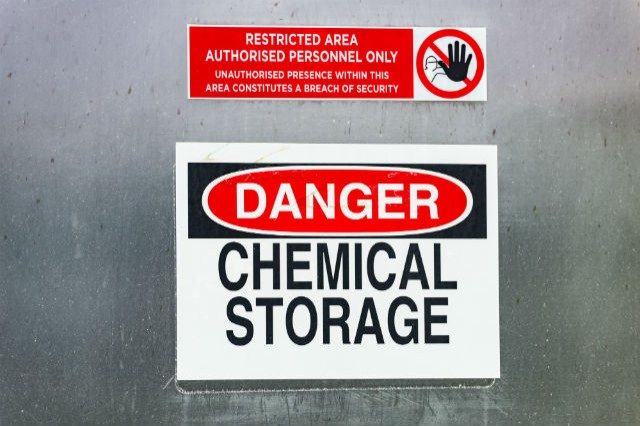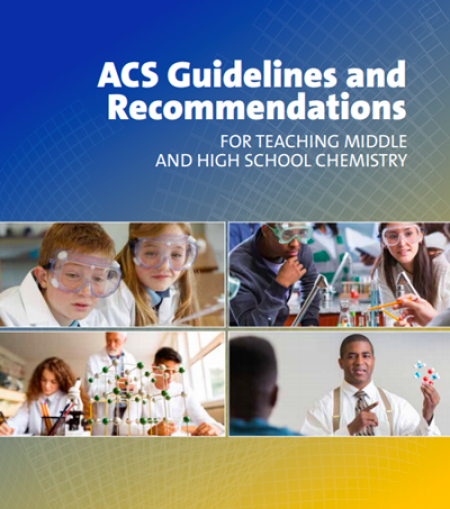Chemical Storage
Chemicals should be methodically stored and organized. Teachers should account for hazardous chemicals and chemical incompatibility when organizing their store rooms.
The chemical storage area should be securely locked when not in use.
Teachers will have chemicals that are considered hazardous in their laboratories. These chemicals may be needed for a specialized lab or left behind from a previous teacher. Some schools and/or districts specify chemicals that are absolutely not allowed in schools. If a school or system does not limit what chemicals can be in a classroom setting, you can consult the ACS Restricted-Use Chemicals list (pages 3–9) in the document Reducing Risks to Students and Educators from Hazardous Chemicals in a Secondary School Chemical Inventory (PDF). This list indicates whether a chemical is explosive, toxic, an irritant, carcinogenic, corrosive, an oxidizer, poisonous, an allergen, flammable, or capable of creating violent reactions. It is an extensive but not all-inclusive list; its intent is not to prohibit the use of these chemicals, but to ensure that teachers are aware of specific hazards and can take the appropriate safety precautions to prevent exposure.
Incompatible Chemicals
Another important aspect of storage is making sure that incompatible chemicals are physically separated when stored. Consult the table (PDF), created by AACT, to determine which chemicals may or may not be stored together. Chemical should never be stored alphabetically; this can allow incompatible chemicals to be near each other and react inside storage cabinets. Flinn Scientific offers help for teachers to organize their chemical storage area with this quick reference, which accounts for storage of incompatible chemicals. Note that there are limits to how long and in what quantities chemicals identified as waste can be stored. When setting aside chemicals for hazmat pickup, keep this in mind.
Table of Incompatible Chemicals
| Acetic acid | Chromic acid, nitric acid, peroxides, permanganates |
| Acetic anhydride | Hydroxyl group containing compounds, ethylene glycol, perchloric acid |
| Acetone | Concentrated nitric and sulfuric acid mixtures, hydrogen peroxide |
| Acetylene | Bromine, chlorine, copper, fluorine, mercury, silver |
| Ammonium nitrate | Acids, chlorates, flammable liquids, nitrates, powdered metals, sulfur, finely divided organic or combustible materials |
| Aniline | Hydrogen peroxide, nitric acid |
| Calcium oxide | Water |
| Carbon, activated | Calcium hypochlorite, other oxidants |
| Chlorates | Acids, ammonium salts, metal powders, sulfur, finely divided organic or combustible materials |
| Chromic acid | Acetic acid, camphor, glycerol, naphthalene, turpentine, other flammable liquids |
| Chlorine | Acetylene, ammonia, benzene, butadiene, butane and other petroleum gases, hydrogen, sodium carbide, turpentine, finely divided metals |
| Copper | Acetylene, hydrogen peroxide |
| Hydrazine | Hydrogen peroxide, nitric acid, other oxidants |
| Hydrocarbons | Bromine, chlorine, chromic acid, fluorine, peroxides |
| Hydrocyanic acid | Alkalis, nitric acid |
| Hydrofluoric acid, anhydrous | Ammonia (aqueous or anhydrous) |
| Hydrogen peroxide | Aniline, chromium, combustible materials, copper, Iron, most metals and their salts, nitromethane, any flammable liquid |
| Hydrogen sulfide | Fuming nitric acid, oxidizing gases |
| Iodine | Acetylene, ammonia (aqueous or anhydrous) |
| Mercury | Acetylene, ammonia, fulminic acid |
| Nitric acid, concentrated | Acetic acid, acetone, alcohol, aniline, chromic acid, flammable gases, flammable liquids, hydrocyanic acid, hydrogen sulfide, nitratable substances |
| Nitroparaffins | Amines, inorganic bases |
| Oxalic acid | Mercury, silver |
| Nitric acid, concentrated | Acetic acid, acetone, alcohol, aniline, chromic acid, flammable gases, flammable liquids, hydrocyanic acid, hydrogen sulfide, nitratable substances |
| Nitroparaffins | Amines, inorganic bases |
| Oxalic acid | Mercury, silver |
| Oxygen | Flammable liquids, solids, or gases, grease, hydrogen, oils |
| Perchloric acid | Acetic anhydride, alcohol, bismuth and its alloys, grease, oils, paper, wood |
| Peroxides, organic | Acids (organic or mineral) |
| Phosphorus (white) | Air, oxygen |
| Potassium chlorate | Acids (also refer to chlorates) |
| Potassium perchlorate | Acids (also refer to perchloric acid) |
| Potassium permanganate | Benzaldehyde, ethylene glycol, glycerol, sulfuric acid |
| Silver | Acetylene, ammonium compounds, fulminic acid, oxalic acid, tartaric acid |
| Sodium | Carbon dioxide, carbon tetrachloride and other chlorinated compounds, water |
| Sodium nitrite | Ammonium nitrate and other ammonium salts |
| Sodium peroxide | Any oxidizable substances (e.g., acetic anhydride, benzaldehyde, carbon disulfide, ethanol, ethyl acetate, ethylene glycol, furfural, glacial acetic acid, methanol, methyl acetate) |
| Sulfuric acid | Chlorates, perchlorates, permanganates |
Chemical Storage Area
All chemicals should be stored in designated, locked areas designed for chemical storage. Safety features for chemical storage must follow local and state guidelines and recommendations. At the bare minimum the area should contain the following:
- Shelving for chemicals, organized to account for hazards and incompatibility.
- Separate, designated, enclosed cabinets for acids, bases, oxidizers, organics, and other flammables.
- Equipment should be stored in separate cabinets from chemicals.
- If chemical storage is near a classroom with emergency equipment and no physical barrier, then no additional safety equipment is needed in the chemical storage area. If the chemical area is detached from the classroom, it should be outfitted with safety equipment. If the chemical storage room is located remotely, consideration for safe transport must be made (carts, secondary containers, transport time, etc.).
ACS Guidelines and Recommendations
for Teaching Middle and High School Chemistry
An essential resource for middle and high school physical science and chemistry teachers, curriculum developers, principals, and other school administrators who support teachers in those roles.
Learn about the nature of instruction, the core ideas to teach, the physical instructional environment, safety, sustainability, and the professional responsibilities of teachers.



